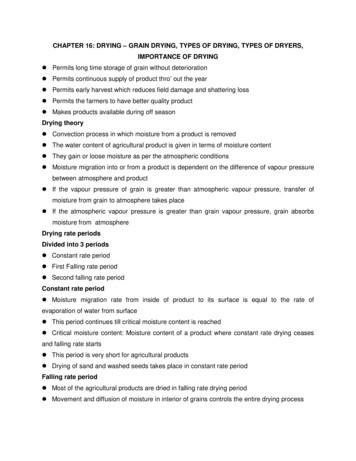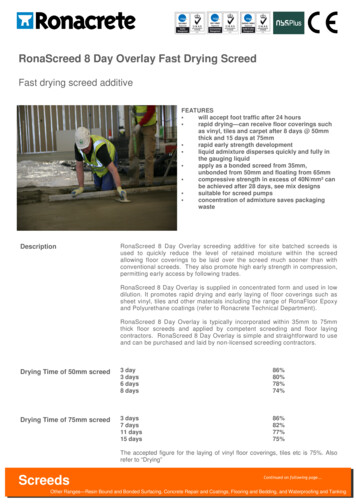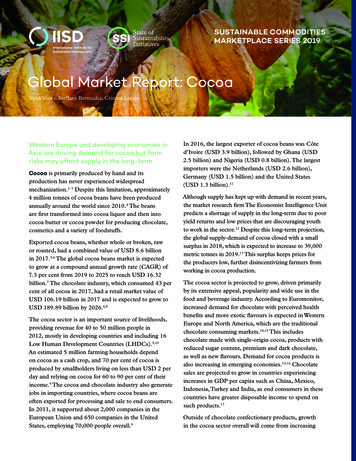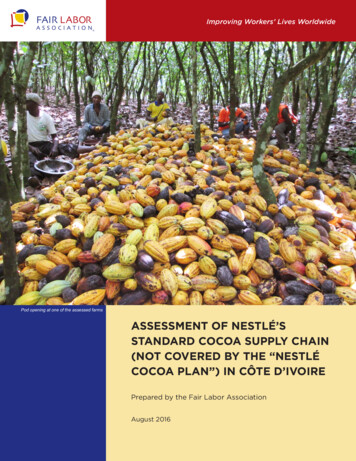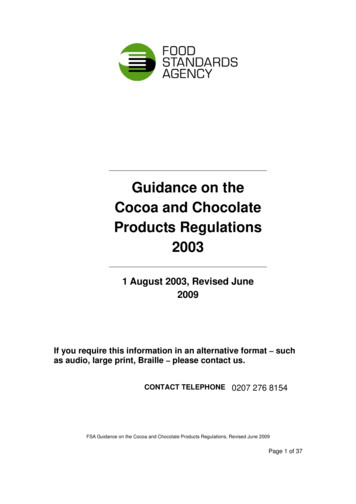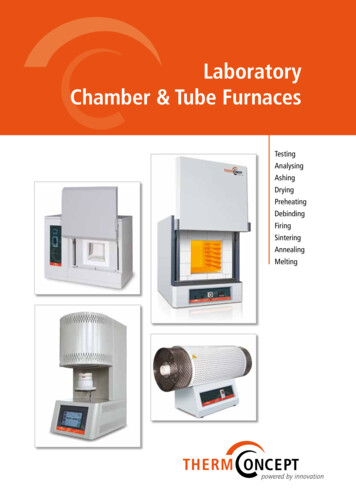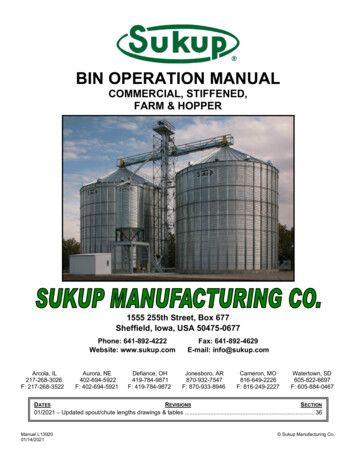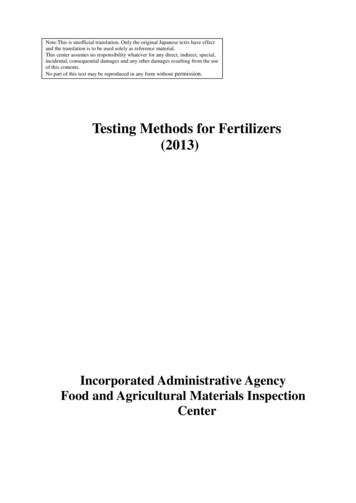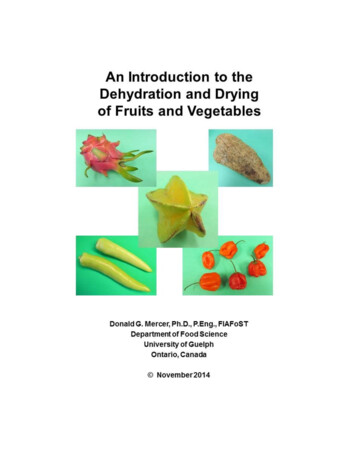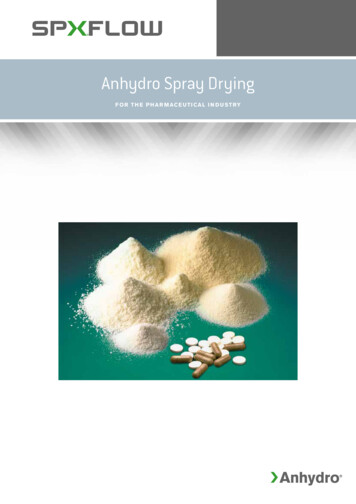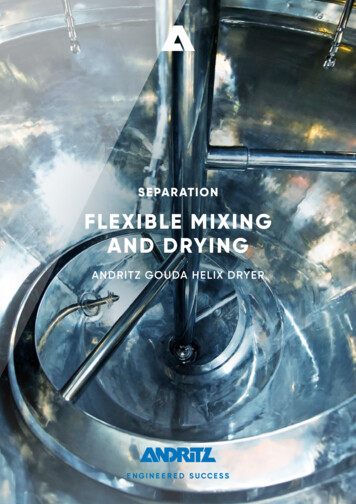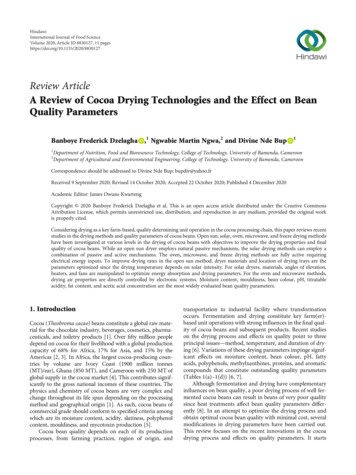
Transcription
HindawiInternational Journal of Food ScienceVolume 2020, Article ID 8830127, 11 pageshttps://doi.org/10.1155/2020/8830127Review ArticleA Review of Cocoa Drying Technologies and the Effect on BeanQuality ParametersBanboye Frederick Dzelagha ,1 Ngwabie Martin Ngwa,2 and Divine Nde Bup121Department of Nutrition, Food and Bioresource Technology, College of Technology, University of Bamenda, CameroonDepartment of Agricultural and Environmental Engineering, College of Technology, University of Bamenda, CameroonCorrespondence should be addressed to Divine Nde Bup; bupdiv@yahoo.frReceived 9 September 2020; Revised 14 October 2020; Accepted 22 October 2020; Published 4 December 2020Academic Editor: James Owusu-KwartengCopyright 2020 Banboye Frederick Dzelagha et al. This is an open access article distributed under the Creative CommonsAttribution License, which permits unrestricted use, distribution, and reproduction in any medium, provided the original workis properly cited.Considering drying as a key farm-based, quality determining unit operation in the cocoa processing chain, this paper reviews recentstudies in the drying methods and quality parameters of cocoa beans. Open sun, solar, oven, microwave, and freeze drying methodshave been investigated at various levels in the drying of cocoa beans with objectives to improve the drying properties and finalquality of cocoa beans. While an open sun dryer employs natural passive mechanisms, the solar drying methods can employ acombination of passive and active mechanisms. The oven, microwave, and freeze drying methods are fully active requiringelectrical energy inputs. To improve drying rates in the open sun method, dryer materials and location of drying trays are theparameters optimized since the drying temperature depends on solar intensity. For solar dryers, materials, angles of elevation,heaters, and fans are manipulated to optimize energy absorption and drying parameters. For the oven and microwave methods,drying air properties are directly controlled by electronic systems. Moisture content, mouldiness, bean colour, pH, titratableacidity, fat content, and acetic acid concentration are the most widely evaluated bean quality parameters.1. IntroductionCocoa (Theobroma cacao) beans constitute a global raw material for the chocolate industry, beverages, cosmetics, pharmaceuticals, and toiletry products [1]. Over fifty million peopledepend on cocoa for their livelihood with a global productioncapacity of 68% for Africa, 17% for Asia, and 15% by theAmericas [2, 3]. In Africa, the largest cocoa-producing countries by volume are Ivory Coast (1900 million tonnes(MT)/ear), Ghana (850 MT), and Cameroon with 250 MT ofglobal supply in the cocoa market [4]. This contributes significantly to the gross national incomes of these countries. Thephysics and chemistry of cocoa beans are very complex andchange throughout its life span depending on the processingmethod and geographical origin [1]. As such, cocoa beans ofcommercial grade should conform to specified criteria amongwhich are its moisture content, acidity, slatiness, polyphenolcontent, mouldiness, and mycotoxin production [5].Cocoa bean quality depends on each of its productionprocesses, from farming practices, region of origin, andtransportation to industrial facility where transformationoccurs. Fermentation and drying constitute key farm(er)based unit operations with strong influences in the final quality of cocoa beans and subsequent products. Recent studieson the drying process and effects on quality point to threeprincipal issues—method, temperature, and duration of drying [6]. Variations of these drying parameters impinge significant effects on moisture content, bean colour, pH, fattyacids, polyphenols, methylxanthines, proteins, and aromaticcompounds that constitute outstanding quality parameters(Tables 1(a)–1(d)) [6, 7].Although fermentation and drying have complementaryinfluences on bean quality, a poor drying process of well fermented cocoa beans can result in beans of very poor qualitysince heat treatments affect bean quality parameters differently [8]. In an attempt to optimize the drying process andobtain optimal cocoa bean quality with minimal cost, severalmodifications in drying parameters have been carried out.This review focuses on the recent innovations in the cocoadrying process and effects on quality parameters. It starts
141312111098765430 h7d 60 60Direct sun dryer (wooden platform)NANANA2-5 d18 hNA10 dNA40 h60 h8d20 h7dVariedNANANANANANANANA30.2 to37.8 CNANANA 60 60Tem ( C) DurationOpen sun dryingOpen sun drying onblack tarpaulin andbamboo mats.Open sun dryingCombined sun andtunnel dryerFull sun dryingSun drying on rack tables,concrete floor,black tarpaulinsOpen sun dryingOpen sun dryingMixed sun & oven dryingSun drying on raisedbamboo matsOpen sun-dryingwith temperingOpen sun drierOpen sun dryingSun drying wood smokeOpen sun drying23Direct sun dryer(wooden platform)Drying method(s)1(a) Open sun drying methodsSet standards (reference values)S. No8.6NA7.57.577-87-852.2 8.0349.4 7.549.953.753.7 .396.5 NA 2353.5 5.49NA57NA53.16 5.56752.2 8.03NA3.85.55.58NApHMC (%)BD NANANANANANANANANANA55-56 15-17%Fat(%)Table 1: Cocoa drying methods and frequently analyzed quality parameters.[31]Bean colour, titratable acidity,acetic acid, & free fatty acid[1][32][14][36][15][52][8]Volatile acidity, free acidityFFA, acetic acidOTA (0:569 0:015 mg/kg)PAHTotal amino acid content, total sugarreduction, ordourPolyphenol content, mould infection,bean colour, and OTA[51][50][49][48][47][1][4, 7, 30]Bean colour, antioxidant activity,phenolic compounds,OTA, titratable acidity, acetic acid,PAH, mouldiness, theobromine,caffeine, dry bean recovery rate,foreign matter, bean count,sound of dry grain, ordour,separation of huskAntioxidant activity, phenoliccompound content(catechin and methylxanthines), OTABean colour, dust, dirt, and otherpollutantsBean colour, titratable acidity, ashcontentBean colour, fat content, crude protein,carbohydratesBean colour, flavourPAHs 6:22 μg·kg-1PAHs 114:92ReferencesOther quality parameters analyzed2International Journal of Food Science
Solar tunnel heat pump dryerSolar dryingTunnel dryer6781211109Forced-air, artificialintermittent dryer5Solar dryer for intermittentdrying forced convectionSolar dryer for intermittent drying naturalconvectionSolar dryer with adsorbentSolar dryer with absorbentOven drying with curing of 24 h after 3hours of continuous dryingMobile solar dryerHeated batch cocoa bean dryerGreenhouse dryerNA6040-5432 h57NANA41 h30 h52 ANANA6.08- 12.025.7 tentNANANANA50Fat(%)NA5.46–4.97NA5.2pH13– 5.37–14 5.396.5 NANANA3.674.94.88.6NA66-87.58.16.97.765.7MC (%)BD ADNA72 hNA50,55,60,65, 70,75,80, & 8531-548D20 hNA6h5h4h6.3d4.8dNA29.6-48.855708135, 40,45,50, & 5531-35 607d60 6060Greenhouse dryer(plastic roof with UV protection)Dryer with wooden platformMixed dryer (plastic roof without UVprotection and exposure to sun light)Cocoa house replica dryer7d30.9Tem ( C) DurationSolar greenhouse dryerMixed dryer (plastic roof without UVprotection and exposure to sun light)Drying method(s)4321(b) Solar dryingmethodsS. NoTable 1: Continued.Bean colour, fat content, crudeprotein, carbohydratesBean colour, flavourWeight stabilityAcid value, bean colour, bitterness,mouldiness, free fatty acid level,moisture reabsorption rateProtein (%), fibre, ash, & CHOBean colour, dust, dirt, and otherpollutantsBean colour, titratable acidity, ashcontentFree fatty acid, acetic acid levelsNABean colour, water activity, cocoaflavour,total acidity, bitterness, astringencyAntioxidant activity, phenoliccompound content (catechin andmethylxanthines), OTADry bean recovery rate, foreign matter,bean count, bean colour, brown fatAntioxidant activity, phenoliccompound content(catechin and methylxanthines), OTAOther quality parameters ][4]ReferencesInternational Journal of Food Science3
Mechanical (tunnel) dryerIndirect heavy load solar dryerIntegrated solar dryer withadsorbent desiccantPolycarbonate tunnel solar dryer (equippedwith electric fans)Integrated solar dryer withabsorbent desiccantSolar dryingSweat box drying (100 W bulb)Sweat box drying (200 W bulb)Sweat box drying (300 W bulb)Sweat box drying (400 W bulb)1415194060NA60-8060Humidity controlled dryerchamber (laboratory oven)Wood smokeOven dryingAdsorption drying23460Dryer with wooden platformMechanical oven 60Greenhouse dryer(plastic roof with UV protection)1(c) Oven drying method20NATray dryerSolar cabinet dryer,186020 kg30 kg60 kgNANA40-706050556012-40 h24 hNA12, 24, 32,& 40 h4.3d7d9h9h8h7h6h5d7d9d8h16 h19 h24 h30 h7dNA9.25 h8.5 h7.1 hTem ( C) DurationDirect solar dryer at threelevels of loading1716Rotary dryer equipped with an electricheater and infrared lampsDrying method(s)13S. 766.96.47.68.17.513146.37.577MC (%)BD ADTable 1: ANANANANAShellcontentPolyphenol contentBean colour, water activity,cocoa flavour, total acidity,bitterness, astringencyPolyphenol contentment,astringency, flavour, bitternessPAHs 142:05Antioxidant activity, phenoliccompound content(catechin and methylxanthines),OTABean colour, titratable acidity,acetic acid, & free fatty acidMouldiness, titratable acidityNAMouldiness, bean colour, sound ofdry grain, ordour, separation of huskTotal amino acid content, totalsugar reduction, ordourTitratable acidity, bean colour, ordourPolyphenols, caffeine, theobromine,epicatechin and catechin contentOther quality parameters ][6]References4International Journal of Food Science
Microwave oven4NA0.4 h4h24 h250 sec350 sec450 sec24 h8 mins12 mins16 mins18 hNA33 h24 h2-5 d39 h49.956.4557.16.677.55.6053.5 5.635.777.56.856.7553.7 6.706.625.353.7 7-8MC (%)BD (%)NANANANANANANAShellcontentBean colour, titratable acidity,acetic acid, & free fatty acidNAPolyphenol contentNAVolatile acidity, free acidityFFA, acetic acidPAHOther quality parameters analyzed[31][46][59][44][32][14][15]ReferencesKey: d days; h hours; mins minutes; sec seconds; EE electrical energy; W watts; NA not available; MC moisture content; BD before drying; AD after drying. The italic data show contents that fallbelow or above the set standards.Domestic microwave ovenVacuum drying-50 C60600 W300 W150 W -30 C321Freeze drying (fresh beansblanched at 90 C for 5 minutes)Oven drying73200 W2800 W2400 WOven drying66080354045505560Tem ( C) DurationMicrowave dryingVacuum dryingFull electric oven5(d) Microwave andfreeze drying methodsDrying method(s)S. NoTable 1: Continued.International Journal of Food Science5
6with a brief description of the most popular drying methodsused in the drying of cocoa beans, recent advancements inthe drying technology, and effects on bean quality parametersand ends with a tabulated summary of the drying methodsand quality parameters.2. Cocoa Drying MethodsAny drying system which minimizes exposure of food to light(ultraviolet (UV)), oxidation, and heat will help conservecritical bioactive compounds required for high producequality [9].During drying, the water activity of food is reduced due toa reduction in its moisture content through the application ofheat [10]. Cocoa beans are considered dry and suitable formarketing if the moisture content has been reduced tobetween 5 and 8% (wet base) [11]. As reviewed by Bala andNipa [12] and Naseer et al. [9], five types of drying systemsemployed in the cocoa sector have been identified, namely,the open sun, solar, oven, microwave, and freeze drying. Theseare briefly reviewed below, as the basis on which various workshave been carried out aimed at improving the drying potentials of the dryers and the quality of the dried cocoa beans.2.1. Open Sun Drying. Sun drying is the oldest, cheapest, mostpopular, and freely available method that can be appliedusing the most rudimentary to highly sophisticated and scientific procedures, especially in the tropics and subtropicswhere solar radiation is abundant [12]. Over 60% of Africanand Asian cocoa is dried locally using the open sun [3], themain reason for the usually higher moisture content at thetime of sale by the farmers. Among renewable energyresources, solar energy is considered indispensable in thefuture, as it is inexpensive, abundant, inexhaustible, environmental friendly, and nonpollutant [13].Open sun drying is widely carried out by spreading thebeans on raised wooden mats and plastic sheets or on concrete floors during sunshine (Table 1(a)). The beans are manually turned regularly, and someone needs to stay by to scareaway the biotic contaminants and also to carry the beans tothe shade in case of rain. Though freely available, this methodis weather dependent, is labour intensive, takes longer (7-22days), and exposes food to vermin and other environmentalcontaminants [14]. This increases the risk of giving poorquality beans compared to the more controlled dryingmethods, as longer drying periods expose the beans to mouldgrowth [15]. Some poorly informed farmers dry their cocoabeans on a bare ground (exposing them to contaminationby stones, soil, and surface organisms) and some on tarredroad sides (exposing them to contamination by carcinogeniccompounds) [3, 8]. Though the cheapest and most freelyavailable to every farmer, this method is not practically feasible during periods of heavy rain and high humidity.2.2. Solar Drying. According to Fagunwa et al. [16] and Sneha[17], solar dryers are devices that use solar energy to dry substances, especially food using solar energy. The dryer heatsthe air to a constant temperature, and the heat generated isused to dry the produce items in the drying chamber and alsoInternational Journal of Food Scienceheats up the surroundings. The air used for drying is passedthrough a collector surface, gets heated, and is then used todry the food item inside the dryer. While the produce isexposed to solar radiation and wind in open sun drying, itis contained in an enclosed space and protected from directwind in solar dryers. Ventilation is enabled at a constant ratethrough defined air inlets and outlets, small solar ventilators,or temperature difference, either due to exposition or due tovertical height [18]. Although solar dryers are mostly used todry cocoa beans at experimental and research levels, a fewfarmer corporative groups in Asia have used the greenhousedryers to dry cocoa beans in a large scale [12].As reviewed by Sivakumar and Rajesh [19] and Sneha[17], together with several workers, they have identified fourtypes of solar dryers (Table 1(b)): the direct solar dryer (e.g.,solar box dryer) is where the item to be dried is exposeddirectly to solar radiation through a transparent material thatcovers the structure. The heat generated from the solarenergy is used to dry the produce and also heats up the surroundings. The indirect solar dryer (e.g., solar cabinet dryer)is where the solar radiation is absorbed and converted intoheat by another surface (like a black top) usually called thecollector. The air that will be used for drying is passed overthis surface and gets heated, which is then used to dry thefood item inside the dryer. The mixed-mode dryers (e.g., solartunnel dryer) employ the use of the direct and indirect passive sources of heat energy to dry the produce, while thehybrid solar dryers (e.g., hybrid solar/biomass cabinet dryer)employ the passive and active sources of heat energy to drythe produce.Where some form of intervention is applied to controlthe drying temperature, such as the use of electric fans toinfluence air flow, the dryers are described as active, in contrast to the passive modes where the drying temperature isfully dependent on natural weather. Although it is moreexpensive and complex to construct compared to direct solardryers, some of its advantages include conservation of produce from external contaminants, less human labour, andavailability in varied sizes. Based on the design of systemcomponents and mode of utilization of solar energy, threetypes of solar drying systems have been reviewed [19, 20].The natural convection solar dryer (passive dryers) is aportable direct type which consists simply of a rectangularshaped with a transparent top and blackened interior surfaces. A clear polyethylene plastic is placed over the heat collector to allow solar radiation to heat the air. A black materialis also placed under the chamber to absorb the heat and tokeep out moisture from the ground. Another black polyethylene sheet could also be placed over the drying chamber toprevent bleaching. Ventilation holes may not be providedalong the sides, but an opening in the front of the unit allowsambient air to enter the heating chamber, and another opening at the rear of the drying chamber allows moist air toescape from the unit by natural convection air movements.This dryer is unlikely to be suitable for drying the large quantities of coca produced by farmers, though it may give acceptable experimental results.The forced convection dryer (active dryers) is a directmode forced convection dryer which essentially consists of
International Journal of Food Sciencea blower to force the air through the product and a chamberand is covered with a transparent sheet. Indirect mode forceddryers essentially consist of an air heater, a drying chamber,and a blower/fan to duct the heated air to the drying chamber. The drying chamber may consist of several trays to contain thin layers of drying produce.The third type, a hybrid solar dryer, is a modification ofthe two types above and includes the solar drying system withthermal storage such as the forced convection greenhousesolar dryer. The solar drying system with auxiliary unit iscomposed of an electric heating collector, a drying chamber,a fan, and an auxiliary heater. The hybrid with geothermal orwaste waters employs a drying agent as a heating source butcould use solar energy, geothermal or waste waters, a conventional source, or conventional and unconventional energysources. Other modifications include the solar drying systemwith photovoltaic, solar drying system with heat pump [21].A solar drying system with a chemical heat pump consistsof four mean components—solar collector (evacuated tubestype), storage tank, chemical heat pump unit, and dryerchamber. A cylindrical tank could be selected as a storagetank. The chemical heat pump unit contains the reactor,evaporator, and condenser. The general working of chemicalheat pump occurs in two stages: adsorption and desorption.2.3. Oven Drying. A drying oven is a type of low-temperatureconvection or forced air oven used primarily in laboratorysettings. Specimens, tools, and temperature-sensitive chemicals are placed inside a drying chamber to slowly and evenlyremove moisture. An electric dehydrator is a self-containedappliance with a heat source, a fan for circulation, and multiple trays for drying many foods at one time. Better qualitydehydrators also have thermostats and double-walled construction for more efficient energy usage [22]. As such, anyresearcher can dry any produce at any temperature for experimental purposes (Table 1(c)).A local firewood oven dryer was constructed in Fako,Cameroon, with bricks and cement plastered and a tiltingplatform to support the suspended heating and combustionchamber above the ground [3]. To control the effect ofsmoke, the combustion chamber was separated from the drying chamber with 2 m heat/air conveying ducts (the kiln), inwhich dry wood was burnt to generate heat. The drying matwas perforated to facilitate the free circulation of air in thedrying chamber. The rotation rates of the cocoa beans duringthe drying process and the rate of free exit of saturated airwere the same as the rate of entry of hot/dry air into the drying chamber. Although this gave encouraging results (7%within 96 hours of continuous drying), the difficulty to control smoke and maintain the drying temperatures at 3540 C and equality in the distribution of heat were some ofthe risks observed in the experimental process. Further studies are still expected on the dimensions of other cocoa beanquality parameters such as PAHs, acidity, mould content,and OTA content in Cameroon; over 40% of total cocoa productivity is dried using firewood ovens [3].2.4. Microwave Drying. Microwave drying is a process thatbasically works in the same way as when we heat food in a7microwave oven. The microwaves cease at the same momentas the drying machine or microwave oven is switched off.According to Feng et al. [23], microwave drying is based ona unique volumetric heating mode facilitated by electromagnetic radiation at 915 or 2,450 MHz. The responses of a lossyfood product to dielectric heating result in rapid energy coupling into the moisture and lead to fast heating and drying.A significant reduction in drying time in microwave dryingis often accompanied by an improvement in product quality,making it a promising food dehydration technology. The needfor improvement in engineering design and process optimization for microwave drying has stimulated the development ofcomputer simulation techniques to predict temperature andmoisture history and distribution in the product to be dried.Despite the experimental successes that this method mayachieve in the drying of cocoa beans, it is limited to verysmall-scale drying and practically unsuitable for unelectrifiedrural areas and large-scale production of cocoa (Table 1(d)).Microwave drying relies on additional energy being supplied that is preferentially absorbed by the solvents in theprocess to enhance evaporation. Microwaves are a form ofelectromagnetic energy (300 MHz–300 GHz), generated bymagnetrons under the combined force of perpendicular electric and magnetic fields. Microwave heating is a direct heating method. In the rapidly alternating electric fieldgenerated by microwaves, polar materials orient and reorientthemselves according to the direction of the field. The rapidchange in the field at 2450 MHz causes rapid molecular reorientation resulting in friction and heat. Different materialshave different properties when exposed to microwaves,depending on the extent of energy absorption, which is characterized by the loss factor [24].2.5. Freeze Drying. First used in 1949, freeze drying is a special form of drying that removes all moisture and tends tohave less of an effect on a food’s taste than does normal dehydration. In freeze drying, food is frozen and placed in a strongvacuum. The frozen water in the food turns to vapour (sublimation) [25, 26]. Although this method has been provensuitable in the experimental drying of cocoa beans, it seemspractically impossible to be used in the large-scale drying ofcocoa beans due to its high electrical and technical inputs.3. Effect of Drying Method on Some QualityParameters of Cocoa BeansCocoa has been savoured for over 3500 years for its rich flavour, ability to uplift mood, and capacity to increase energy.According to Ishaq and Jafri [27], Mandl [28], and HerbaZest[29], nutritional and health benefits of cocoa and its productsinclude supporting brain health, a good source of antioxidants, regulating blood cholesterol level, and treatment fordiabetes and bronchial asthma; reduce obesity; regulate cardiovascular health; treat constipation; prevent cancer; andsupport skin health. For cocoa beans to qualify for use bythe chocolate and pharmaceutical companies, an analysis ofthe following quality parameters is required: moisture content (5.5-8% wet basis), pH (3.8-5.5), fat content (55-56%),shell content (15-17%), brown bean colour, free from
8moulds, high antioxidant activity, phenolic compounds,OTA, titratable acidity, acetic acid, PAH, theobromine, caffeine, dry bean recovery rate, foreign matter, bean count,sound of dry grain, ordour, and separation of husk [4, 7,30]. Drying being a key quality determinant unit operationin the cocoa chain, variations of drying methods, temperature, and duration of drying have been extensively studiedin relation to effects on quality attributes [6, 7].Using the solar cabinet, a microwave oven, and open sundryers, the drying characteristics of cocoa beans were evaluated. Although a high cut test score of 94.5% was obtainedin all the dryers, free fatty acid content was the highest(9.42) in beans from the tray dryer while pH was higher thannormal in the solar cabinet and microwave oven dryers (6.3and 7.2) [31]. In decreasing rating of quality, cocoa beansfrom the tray dryer were the highest, followed by that fromthe solar cabinet, the open sun, and the microwave. Despitethe significant reduction in drying time, the microwave dryercould be considered not suitable for drying cocoa beansbased on bean quality output.To evaluate the influence of drying methods on antioxidantactivity and Ochratoxin A in cocoa beans, Deus et al. [1] driedproperly fermented beans using four comparative solar dryers—one with stainless steel platform and plastic roof with UVprotection, the second with a wooden platform and an artificialheat source (60 C), a traditional dryer in barge with woodenplatform and drying by direct sun light, and a mixed dryer withstainless steel platform and mobile plastic roof without UV protection and exposure to sunlight. A reduction in antioxidantactivity, i.e., phenolic compound content (catechin from0.04 mg·g-1 to 0.02 mg·g-1) and methylxanthines (theobrominefrom 19.44 to 11.71 mg·g-1) was observed with only one sampleshowing contamination by OTA (7.1 μg·kg-1). Despite the modifications in the drying methods, the traditional drying methodshowed the highest conservation of antioxidant activity, methylxanthines, and phenolic compound contents. These methodstook a considerably long period of seven days to dry cocoabeans to the required 7% moisture content (wet basis) and, assuch, may not be considered very suitable for large scale dryingdue to the increased risk of quality loss.The performances and effects of open sun, oven, and mixedsun and oven drying methods on the chemical quality attributesof raw cocoa were evaluated [32]. The open sun and mixeddryers gave favourably lower free fatty acid ( 0.70%) and freeacidity contents. Cocoa beans from the oven and mixed dryerswere more acidic (pH 3.8–5.2) compared to the more suitableacidity (pH 4.5-5.5) from the open sun dryer. Despite theacceptable bean quality, these results were not conclusive as drying time and temperature were not monitored as expected.To compare the effects of open sun and oven drying(temperatures 35, 40, 45, 50, and 55 C) on the quality of fermented cocoa beans, the assessment of acetic acid level, pH,bean colour, free fatty acid, acid value, and grading was carried out [14]. Although sun-dried samples gave better resultsthan the oven dried at all temperatures, the significantincrease of free fatty acid and acetic acid levels with increasein temperature was directly proportional the correspondingdecrease in pH, with optimal oven temperature being 45 C.Due to the required expertise and high operational cost, thisInternational Journal of Food Scienceoven method may not be recommended for the large-scaledrying by rural farmers.Using a solar greenhouse dryer (at temperature of 21–52 C), fermented cocoa beans were dried to 5.3% moisturecontent (wet basis) within seven days [33]. Although theresults were not encouraging due to the long drying timeand a low cut test score and brown fat content of 74% and50%, respectively, the enclosed nature of the greenhouseeliminates the risk of mould and external bean contamination by rain and vermin. This could be advantageous to ruralfarmers if properly constructed and drying propertiesenhanced.Using a heated batch drier at 55, 70, and 81 C under isothermal conditions, the drying kinetics of foreign cocoa species were investigated in Abia State, Nigeria [34]. Moisturecontent of batches was reduced to 5, 3, and 4% wet basiswithin 12, 6, and 4 hours of drying. In a similar investigation,a convective hot air dryer at 60, 70, and 80 C reduced themoisture contents of cocoa beans to 6.3, 5.7, and 3.6%,respectively, within eight hours [35]. Despite the significantreduction in drying time, drying cocoa beans at temperaturesabove 60 C is discouraged due to high retention of acetic acidand increase in bitterness [14, 31].The influence of fermentation and drying materials onthe Ochratoxin A (OTA) content in cocoa beans was evaluated using the open sun on rack tables, concrete floor,and black tarpaulins [36]. The OTA content increasedfrom 0:275 0:2 μg/kg (during fermentation) to 0:569 0:015 μg/kg (during drying), but no significant relationships between the OTA level and the materials used inthe fermentation and drying were established.Using a direct solar dryer to investigate the effect of different loadings (20, 30, and 60 kg), the moisture content ofcocoa beans was reduced to 7.5% in 5, 7, and 9 days of drying,respectively [37]. The pH of the dried beans was within range(5.1, 4.9, and 5.4), a reduction in titratable acidity (from 25.75to 17.80, 18.57, and 13.30), and increase in mouldiness (light,moderately heavy to extremely heavy) in the 20, 30, and 60 kgloadings, respectively. Together with other quality assessments (bean colour, odour (vinegary, alcohol, faecal, rancid,cheesy, and sock), fermentation index, bitterness, and sourness), the 20 kg treatment produced better quality beanscompared to other loadings and therefore is recommendedfor the direct solar dryer. Sacrificing quantity for quality disqualifies this drying method for use by large-scale farmers.To investigate the effect of d
BD AD Set standards (reference values) 60 Varied NA 5.5- 8 3.8- 5.5 55-56 15-17% Bean colour, antioxidant activity, phenolic compounds, OTA, titratable acidity, acetic acid, PAH, mouldiness, theobromine, ca ff eine, dry bean recovery rate, foreign matter, bean count, sound of dry grain, ordour, separation of husk [4, 7, 30] (a) Open sun .
